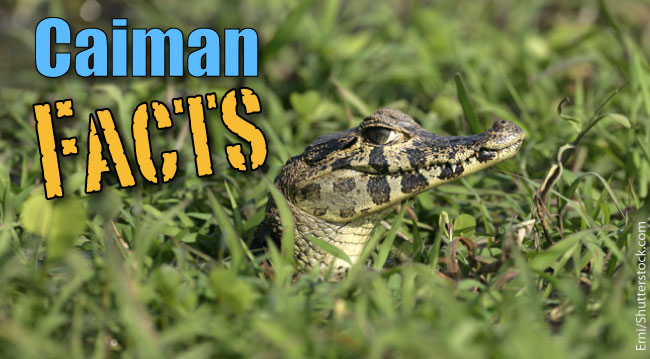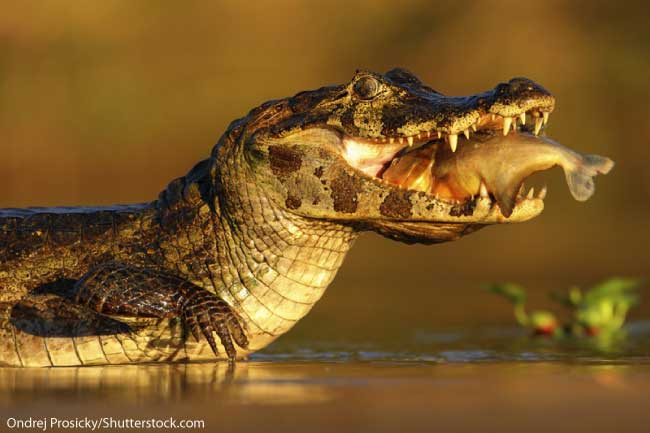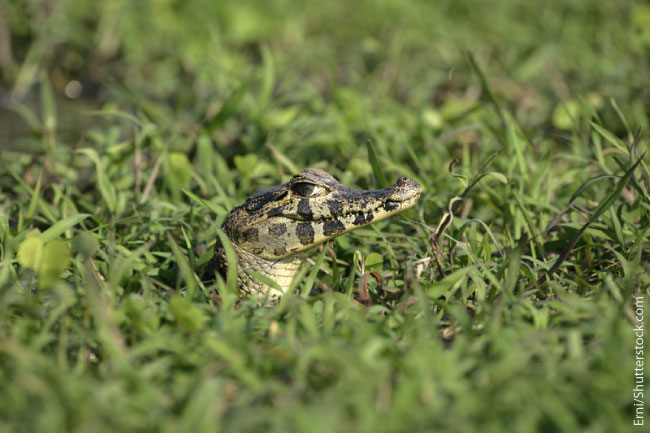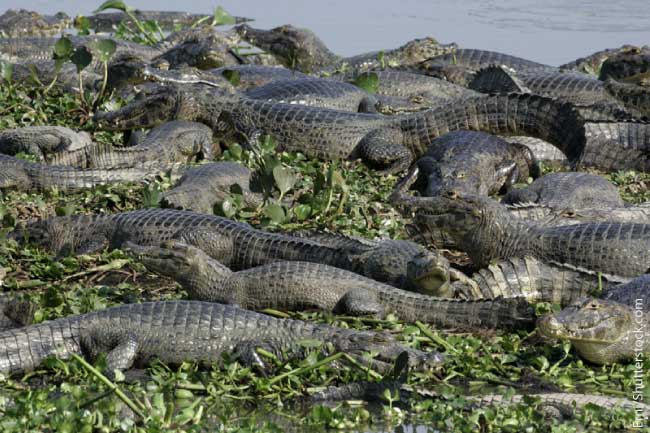Caimans are carnivorous reptiles in the family Alligatoridae. Their closest relatives are the alligators. Caimans are found in a variety of habitats in Central and South America.
Let's find out more about these fascinating crocodilians...
- This article is part of our Rainforest Animals series.
Caiman Information
Caimans live in the rivers, swamps, forests and marshes of Central and South America. Caimans are carnivorous (meat eating), semi-aquatic reptiles.
Caimans, along with alligators, belong to the family Alligatoridae. Alligatoridae is part of a larger group of reptiles: the order Crocodilia, which also contains crocodiles and gharials. Members of this order are known as "crocodilians".
- You can find out more about the different types of reptile on this page: Reptiles: The Ultimate Guide
There are six species of caiman:
- Spectacled Caiman (Caiman crocodilus)
- Yacare Caiman (Caiman yacare)
- Broad-Snouted Caiman (Caiman latirostris)
- Black Caiman (Melanosuchus niger)
- Cuvier's Dwarf Caiman (Paleosuchus palpebrosus)
- Smooth-Fronted Caiman (Paleosuchus trigonatus)
The smallest caiman is Cuvier's dwarf caiman, which is 3.9 to 4.6 ft. / 1.2 to 1.4 meters in length.
The largest is the black caiman, which grows to over 16.4 ft / 5 meters in length.
In all species of caiman, males are bigger than females.
Only the black caiman is large enough to be considered dangerous, but even smaller species have strong bites, as this reporter finds out...
You can find out more about the different species of caiman further down the page.
Caiman Facts: Crocodilians
Like all crocodilians, caimans are long, squat creatures, with big jaws, long tails and short legs. They have thick, scaled skin, and their eyes and noses are located on the tops of their heads. This enables them to see and breathe while the rest of their bodies are underwater.
Caimans are better adapted for swimming in the water than walking on the land. When swimming, caimans propel themselves by moving their tails side to side; the legs are not used.
The are six species of caiman vary in size, appearance and the habitat in which they are found.
All caimans have extremely tough skin for protection. Caiman species range in colour, from pale green to black.
Watch the film below to see incredible footage of Yacare caimans in the wild.
Where Do Caimans Live?
Caimans live in Central and South America, in countries such as Brazil, northern Argentina, Uruguay, Paraguay, and Bolivia. The spectacled caiman is the most widespread, and is also found further north than other species. The Yacare caiman is found further south than other species.
Caiman Facts: Caiman Habitat
Caimans live in freshwater rivers and streams in Central and South America. Spectacled caimans can also tolerate salty water, which gives them a wider potential range.
What Do Caimans Eat?
Caimans are carnivorous, and eat a wide range of animals. All caiman eat fish and small mammals. The larger the caiman, the larger their potential prey. Larger species can hunt mammals such as capybaras and a black caiman might even fancy its chances against a jaguar.
Black caimans are the apex predators in the Amazon. This means that they are top of the food chain, and have no natural predators.
The other caiman species may find themselves dinner for predators such as green anacondas and jaguars.
Reproduction
Like many – but not all – reptiles, caimans lay eggs. Before laying her eggs, the female caiman builds a nest. This is a mound of vegetation and soil. As the vegetation at the bottom of the nest rots, it produces heat, which warms the eggs.
Caimans can lay up to 40 eggs in the nest. Female caimans protect the nest from potential egg-thieves such as snakes and small mammals.
Small temperature differences in the nest can determine the sex of the hatchlings. Colder nest temperatures produce male hatchlings. Some caimans lay eggs in different layers to ensure an even gender distribution.
The eggs hatch after 70-90 days. The female caiman then leads the group of hatchlings – known as a ‘pod’ – to the water. The young caimans are reared in safe ‘nursery’ areas for several months. Caimans can take care of each other’s pods.
Caimans Vs Alligators
Caimans are very similar to alligators, and there are only small differences between them. Caimans have more pointed snouts (noses), and longer, sharper teeth than alligators. Although the biggest species of caiman (the black caiman) is bigger than any alligator, most caimans are smaller.
Are Caimans Endangered?
In the past, caimans have suffered from being hunted both for their skins and for their meat, but they are not currently endangered. However, local populations are threatened in some areas. These species are all found elsewhere, so world populations are not considered to be at risk.
Like many rainforest animals, caimans are also threatened by habitat loss due to deforestation.
Types Of Caiman
Spectacled Caiman (Caiman crocodilus)
The spectacled caiman is the most common caiman species – and the most common of all the members of the crocodile family. It gets its name from a bony ridge between its eyes, which look like spectacles.
Spectacled caimans grow to around 2 – 2.5 m in length. Females are smaller, growing to around 1.4 m.
This adaptable species can live in salty water, and has a wider range than other caiman species.
Yacare Caiman (Caiman yacare)
The Yacare caiman is very closely related to the spectacled caiman. It is sometimes called the ‘piranha caiman’, because piranhas form part of its diet.
Yacare caimans are similar in size to spectacled caimans.
Broad-Snouted Caiman (Caiman latirostris)
As their name implies, broad snouted caimans have wider noses than other caiman species. They are pale olive-green in colour, and live in slow moving or still waters in forests. Their broad noses are useful for pushing through the foliage of their swampy habitats
Black Caiman (Melanosuchus niger)
Black caimans are the largest species of caiman, and the most dangerous to humans. They are very darkly-coloured, with paler bands around their jaws. Black caimans were almost hunted to extinction. Thanks to conservation measures, they are no longer endangered. Black caimans grow to over 5m in length
Cuvier's Dwarf Caiman (Paleosuchus palpebrosus)
The smallest species of caiman, Cuvier's dwarf caiman, is 1.2 – 1.4 metres long, and weighs between 6 – 7 kg. It lives near fast-flowing cool water. Cuvier's dwarf caimans are sometimes kept as pets.
Smooth-Fronted Caiman (Paleosuchus trigonatus)
Smooth-Fronted Caimans are the second-smallest species of caiman. They grow to around 1.2 – 1.6m in length (some males can grow to over 2m in length). Like their close relatives, Cuvier's dwarf caimans, Smooth-Fronted Caimans are also sometimes kept as pets.
Quick Caiman Facts For Kids
- Caimans are members of the alligator family. There are two types of animal in the alligator family: caimans, and alligators themselves.
- The alligator family is part of a larger group of animals called Crocodilians. This group contains the alligator, crocodile and gharial families.
- Crocodilia are the closest living relations to birds!
- There are more spectacled caimans than any other species of caiman.
- Spectacled caiman can live in brackish (salty) water as well as fresh water, unlike other caiman species who can only live in freshwater habitats.
- Yacare caiman eat piranhas, and are known as ‘piranha caimans’.
- Caimans are not entirely carnivorous: it has been found that they also eat foliage and fruit.
- Around 10 million Yacare caimans live In the Brazilian Pantanal (a huge tropical wetland area). This is thought to be the largest single population of crocodilians.
- Black caimans are generally larger than American alligators (the largest alligators), making them the largest members of the alligator family.
- Black caimans are the biggest predators in South America
- It’s not just leopards and snakes caimans have to watch out for: there have been instances of caiman cannibalism!
We hope that you have enjoyed reading these caiman facts for kids. To find out about other incredible rainforest animals, see this page: Rainforest Animals List.
Subscribe To Active Wild's Free Newsletter
Subscribe to our free newsletter: awesome animal and wildlife information for inquisitive minds!
[mc4wp_form]






